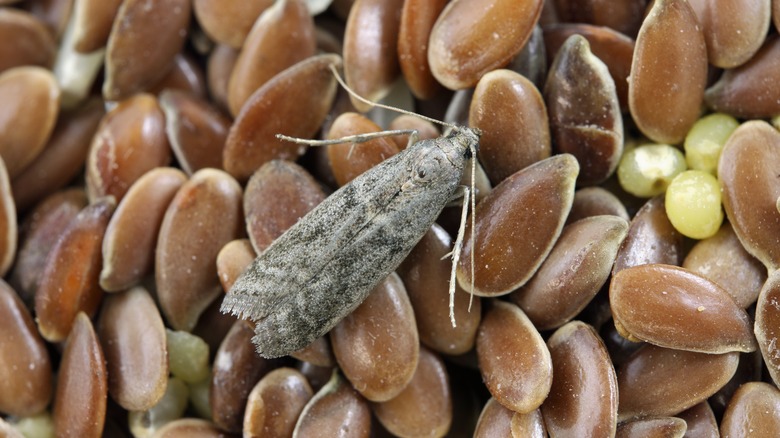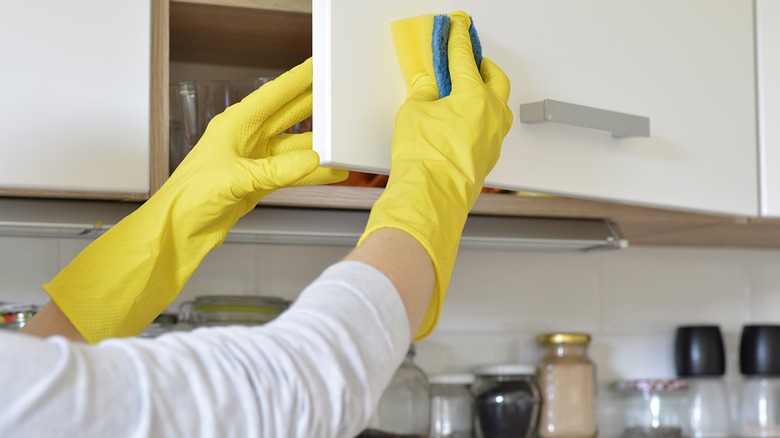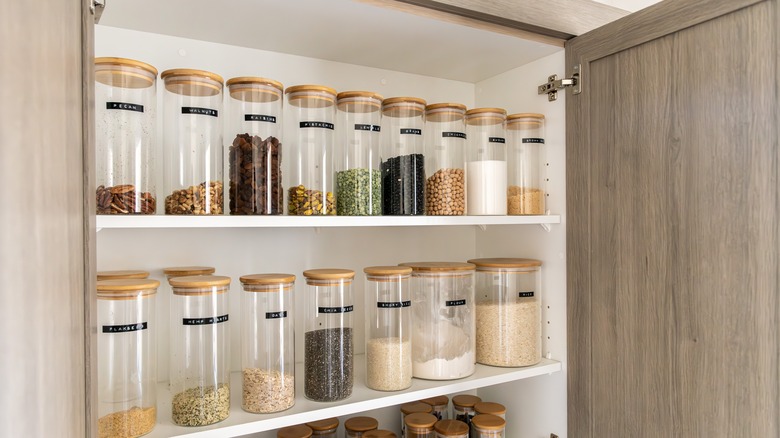Here's How To Properly Clean Your Pantry After Finding Invasive Critters
Finding critters in your pantry? It's as unpleasant as it sounds. Suddenly realizing you're not the only one eating your pantry supplies can definitely make your skin crawl. But look at the bright side: It's the perfect nudge you need to get cracking on a deep clean of your pantry. Tackling this issue head-on might take some time and definitely calls for a bit of reorganization and cleaning of your pantry, but it's entirely worth the effort. Pantry pests, which include the likes of weevils, moths, and beetles, are notorious for sneaking into your home, often hitching a ride via your grocery shopping. These unwelcome guests are quite the opportunists, as they're especially drawn to products that have been opened like cereals and spices. But don't be fooled into thinking unopened items are safe. These pests can be surprisingly adept at infiltrating sealed packages, whether it's through cardboard or plastic.
Once these pests find their way into your pantry, they can quickly become a significant problem. These critters tend to congregate in spots you might not think to check regularly — like in dishes and pans. The real trouble, however, is the risk they pose to your food. Pantry pests are known to contaminate food, leading to waste and potential health risks. You will almost definitely have to throw away large amounts of food if you have an infestation.
Thorough cleaning of your pantry
If you find bugs in your cabinet, the first step in your deep-cleaning process is to completely empty your pantry. Remove every item, from jars and boxes to bags and containers. Inspect each item closely as you remove it from the pantry for any signs of infestation. Sort out your goods into two containers: one for the food you know is absolutely safe and untouched, and the rest of your goods you should put right into a garbage bag.
Now, with your pantry bare, it's vacuum time. Vacuum all the shelves, floors, and those sneaky corners. You're not just sucking up visible pests and crumbs; you're also getting rid of larvae of insects like weevils that might be lurking unseen. And here's a crucial tip: Once you're done vacuuming, dispose of your vacuum contents outside. Consider thoroughly disinfecting your vacuum filter before bringing it back inside. You don't want any hitchhiking pests making their way back into your pantry or house!
Next up, let's give those shelves, walls, and floors a good scrub-down. Grab a bucket of soapy water and wash down all the surfaces in your pantry. This will help remove any remaining traces of pests and their droppings. You can also wipe down with vinegar and water as an alternative. Remember, while it might be tempting to go for stronger chemicals like bleach or ammonia, stick to soapy water. Those harsh chemicals can be dangerous around food. This cleaning process, though intensive, is the most effective way to ensure that your pantry is not just clean but also hygienic and safe for storing your food items.
Preventing future infestations
After you've waged war against the critters in your pantry and won, it's time to focus on defense strategies to keep them from coming back. Preventing future infestations is all about being proactive and maintaining a clean, organized pantry. A key step in preventing future infestations is to store your food in airtight containers. Opt for glass or heavy-duty plastic containers with tight-fitting lids. These containers are tough for pests to penetrate and also make it easier for you to spot any signs of trouble early on. Maintaining a clean and clutter-free pantry is equally important. A tidy pantry doesn't provide hiding spots for pests and makes it easier for you to keep an eye on things. Regularly wipe down your shelves and keep things organized. This might mean taking an extra few minutes to clean up after you've done your grocery shopping, but it's time well spent.
Regular inspections of your pantry items are crucial. Be on the lookout for any signs of pests, like webbing or larvae. If you do find signs of pests, it's better to act immediately and throw out the affected food. This might seem wasteful, but it's a surefire way to nip any potential infestation in the bud. Lastly, don't forget about the physical structure of your pantry. Seal up any cracks or holes in walls or foundations. These can act as entry points for pests. A thorough check and sealing up any potential entry points can go a long way in keeping your pantry pest-free.


